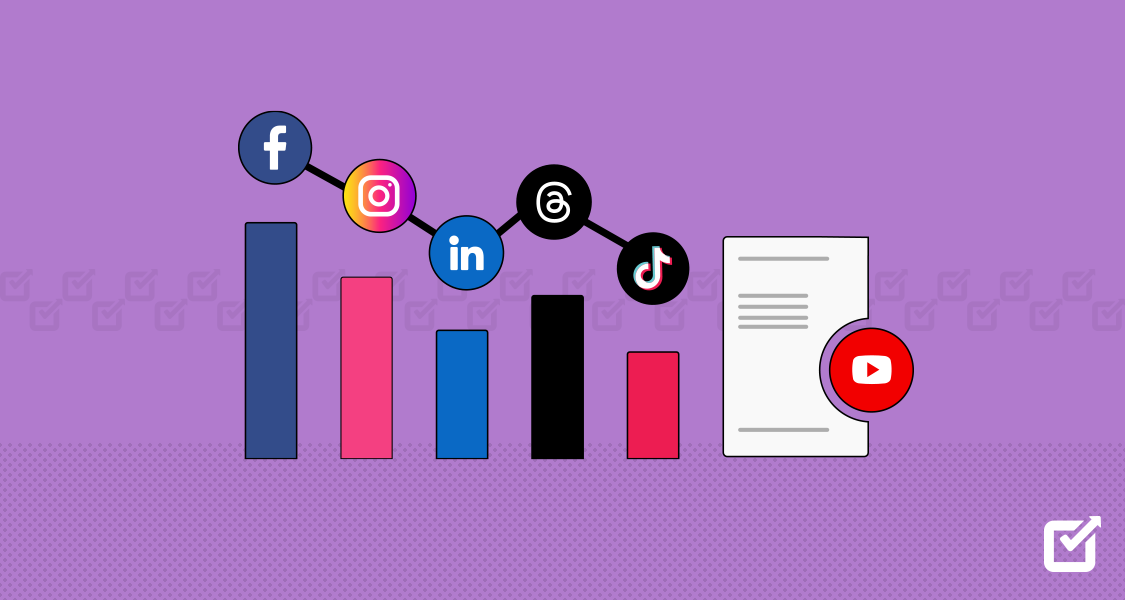Looking to generate more buzz on social media?
Whether you’d like to pivot your current social media marketing strategy — or just double up on what’s working — you can use social media analytics reports to optimize your approach.
Let’s take a closer look at what a social media analytics report is, along with how you can use it to promote growth. We’ll also review 10 of the most popular social media insights you can track and learn from.
What Is a Social Media Analytics Report?
A social media analytics report is a summary of social media key performance indicators (KPI) that businesses monitor to understand how well their social media campaigns perform. By using a social media analytics tool, brands can generate and print out PDF & PPT reports with graphs showcasing weekly and monthly performance.

These reports supply insights about post engagement, audience reach, growth rate, and more.
And they’re becoming quite popular.
In fact, the worldwide market for social media analytics reached a valuation of around seven billion dollars in 2021. It was projected to expand to 8.5 billion dollars in 2022 and exceed 26 billion dollars by 2028 — an increase of nearly seven times in just seven years.
But reporting insights without action is meaningless.
To truly get the most out of social media analytics reporting, you need to apply the lessons you learn.
Let’s explore this further.
How Can I Use Social Media Analytics Reports to Promote Growth?
Social media analytics reports can be powerful tools to promote growth by providing valuable insights and guiding your decision-making process.
Analyzing these reports lets you identify key patterns and trends that emerge from your audience’s behavior and engagement.
We recommend looking for common themes in terms of content type, timing, and messaging that consistently resonate with your audience. This analysis helps you discover the “lesson” behind successful posts and campaigns.
Once you’ve identified these lessons, apply them to your content strategy through A/B testing. Create different versions of your content, incorporating your learned lessons, and measuring their performance.
Test variables such as headlines, visuals, messaging copy, calls-to-action, and posting schedules to determine which versions yield the best results. By using A/B testing, you can refine your approach based on data-driven insights and consistently choose the versions that prove to be most effective.
Elevate Your Social Media Analytics With Social Champ
Try Social Champ free for 7 days and watch your social media performance soar!
10 Social Media Insights You Can Learn From
Here are some of the top social media insights to pay attention to — and how to use them to grow your social media profiles (and business):
Audience Demographics
Audience demographics break down your social media audience.
Shane Barker explains: “Analyzing your audience demographics helps you understand more about your target audience, such as their age, location, and interests.” Apart from basic demographic information, social media analytics can also reveal your audience’s education level, occupation, income range — and even relationship status.
These details help you paint a comprehensive picture of your audience so you can refine your targeting and tailor your messaging effectively.
Best actionable advice: Refine your marketing strategy to reach the right people in the right places. For example, if you find that your audience is mostly located in a specific region, consider focusing your efforts on targeting that particular location.
You can also track users’ interests and hobbies based on their activity, likes, and interactions. This information helps you understand what topics or niches your audience is interested in — so you can create content that aligns with their passions and engages them on a deeper level.
Be sure to also learn how often your audience interacts with your content, which social platforms they prefer, and the times of day they’re most active. This insight allows you to optimize your posting schedule and tailor your content to maximize engagement.
Engagement Rate
Engagement rate measures the level of interaction a piece of content receives on a social media profile. This gives you insight into how well your content resonates with your audience.
It considers actions like likes, comments, shares, or other interest indicators.
It also shows how well your content performs and how engaged your audience is. A higher engagement rate indicates a more involved audience.
To calculate your engagement rate, divide the total number of likes, comments, and shares by the total number of followers or reach.
Best actionable advice: Identify which types of social media posts or topics generate the highest engagement and focus on creating more of them. Test several CTA options with these posts to give your brand a better chance at converting prospects.

Social Champ Analytics For instance, if users can’t get enough of your wealth management advice, consider creating a podcast or YouTube channel dedicated to sharing your insights.
Repurpose audio and video content snippets across your social media profiles to encourage more engagement.
Be sure to add relevant CTAs to encourage conversions, such as “Want to learn more? Sign up for a free discovery call.” Or, “Book a one-on-one consultation with us this week for tailored wealth management advice.”
Reach and Impressions
Reach measures the number of unique users who see your content, while impressions indicate the total number of times your content was displayed.
Monitoring these metrics can help you assess the impact of your social media efforts and identify opportunities to reach a wider audience.
Best actionable advice: Consider a complete content marketing revamp if your reach and impressions are low. This is a key opportunity to learn more about your target audience and what they need from you to be willing to like, know, and trust you.
If your reach and impressions are high, keep doing what you’re doing — but elevate it by showing up more often. You might also consider hosting polls and surveys on your profiles to learn more about what your audience would love to see from you.
Click-Through Rate (CTR)
CTR measures the percentage of users who click on a link in your social media posts.
This valuable metric helps you evaluate your calls-to-action (CTA) effectiveness. You can also reference this metric to optimize your content and encourage more clicks.
Best actionable advice: Test a variety of CTA links that nudge your audience to conversion. Get clear on your business goals ahead of time and consider what kind of “conversion” you’re looking for.
For instance, if you run an ecommerce store, a conversion might be a product sale. Or, if you run a SaaS business, a conversion might be a subscription sign-up.
Here are some CTA options you might consider testing:
- Learn more about (product/service/topic) by (visiting this site/downloading this guide)
- Get started today
- Interested? Head to our (store/site/blog) to learn more
- Buy yours today
- Get yours today
- Sign up now
- Sign up today
- Download your copy before it’s too late
- Get pre-order access today
- Buy now
- Sign up for our email newsletter for exclusive tips
- Enroll today
- Book your free demo
- Book a free discovery call
- Get 15% off — today only
- Get it while it’s on sale! Ends at midnight
Conversion Tracking
If you’ve set up conversion tracking on your social media profiles, you can track actions such as purchases, sign-ups, or downloads.
Analyzing these conversions can help you measure your social media campaigns’ effectiveness and identify opportunities to optimize your strategies.
Best actionable advice: Use conversion tracking metrics to understand which lead magnets convert best in your social media campaigns.
For instance, you might learn that very few audience members are interested in signing up for webinars, but plenty of people love downloading your ebooks and in-depth guides.
With this in mind, create more gated ebooks and in-depth guides, and use the contact information prospects supply to grow your email list. Add these prospects to automated and segmented lead-nurturing email marketing sequences. Learn from their interactions with your email content to push more conversions.
Follower Growth
Keep an eye on your follower growth count over time.
Tracking this metric helps you understand how effective your content is. It also helps you identify the strategies that help your brand attract and retain followers.
Best actionable advice: Take a look at extreme dips and gains in your follower growth over time. During dip seasons, what was different about your social media marketing strategy? During high seasons, what key patterns do you notice in your content?

A snapshot of Social media analytics Use this information to cross out content types (or messaging styles) in your production plan that don’t resonate well with your audience. And double up on the content types and messaging styles that do resonate.
Reach by Post Type
Reach by Post Type helps brands understand how much reach different post types, such as photos, videos, or links, receive. This insight helps you identify which types of content resonate best with your audience. With this knowledge, you can focus on creating more of what works and optimize your content strategy.
Best actionable advice: Dig deep into the posts that get a lot of reach. What do they have in common? Uncover these patterns and then create more content that showcases them.
For instance, you might learn that your posts with the highest reach have social proof and engaging videos and target a major audience pain point.
In this case, you’ll want these attributes to be a standard benchmark in your content creation process going forward. Standardize this by adding it to your social media style guide. Train your social media virtual assistant on your style guide often — be sure to let them know anytime you update the guide so they can take a fresh look at it.
Referral Traffic
Referral traffic helps you understand how much traffic your social media channels drive to your website. This metric shows you how strategic your social media efforts are in generating website visits and conversions.
Best actionable advice: Identify the channels that drive the most traffic to your site and refine your strategy accordingly.
For instance, if Instagram and Facebook are pitiful, but LinkedIn and YouTube drive lots of website traffic, focus your efforts on those channels.
You can also boost the conversion potential on your website by including interactive content — think guided selling quizzes that lead people to the right product or solution for their needs.
Share of Voice
Share of voice helps you gain insights into how your brand or business performs compared to competitors on social media.
With this metric, you’ll analyze the number of mentions, engagement, and reach your brand receives compared to others in your industry. This helps you assess your market position and identify opportunities to stand out and capture a larger share of the conversation.

A snapshot of audience analytics Best actionable advice: Perform a competitor gap analysis to understand which problems your competitors aren’t solving. Then, be the difference-maker by solving that problem better than anyone else could.
For instance, you might notice that your B2B competitors create entertaining videos but don’t include enough value in their content, such as helpful tips, demos, or tutorials. Or you might notice that their social media content is great, but their blog content has low rankings.
You can use these insights to your advantage by adding more value to your social media content, aiming for higher blog SEO content scores, and connecting your blog post strategy with your social media strategy.
For instance, you could repurpose blog snippets from high-ranking posts across your social media content. You could also use CTAs that encourage the user to head to your blog to read the full posts — or to visit your website to learn more or make a purchase. Test all of these CTAs to uncover which ones work best by content type.
Sentiment Analysis
Use sentiment analysis tools to gauge the sentiment behind social media mentions and comments about your brand.
Understanding the overall sentiment helps you measure brand perception and address any negative sentiments promptly and appropriately.
Best actionable advice: Automate mention tracking with social listeningl. Be sure to always respond to every mention — especially negative ones.
Approach negative comments with a helpful and compassionate attitude, as well as a tailored solution.
For instance, if you notice a negative brand mention on Instagram that says, “Worst refinancing service ever. Never go here,” you could respond with a solution, such as:
“We’re incredibly sorry you were unhappy with our service, Laura. Can you please reach out to us at [email protected]? We want to hear more about your experience so we can make this right. You can also book a call with me directly using my Calendly link here. Hope to hear from you soon. Warm regards, Maria Garza, Customer Support Manager.”
Wrap Up
Using social media analytics reports helps you uncover valuable lessons through analysis. You can then apply those lessons through A/B testing and choose the winning versions to optimize your content strategy. By continuously analyzing, testing, and iterating based on the insights from your reports, you can consistently promote growth and drive engagement on your social media platforms.
Here’s to your success!
PS: Need a trusty tool to track users’ actions on your social accounts? With Social Champ, you can download presentation-ready PDF & PPT reports — all from one dashboard.
Get graphs showcasing weekly and monthly performance with Social Champ today.
Start your 7-day free trial. No credit card is required!
FAQs About Social Media Analytics Reports
1. What Should a Social Media Analysis Report Include?
2. What Is an Example of Social Media Analytics?
3. Can You Track Social Media Analytics?
4. What Is the Most Common Use of Social Media Analytics?
A big thanks to Ian David for authoring this post!
Ian David started his career in brick-and-mortar retail management, which quickly included eCommerce and digital marketing as well. He is an avid reader and a self-taught expert in SEO and content marketing. He writes for several publications on a variety of digital marketing topics. Recently, his focus has been on using influencer and affiliate marketing to drive more conversions.













